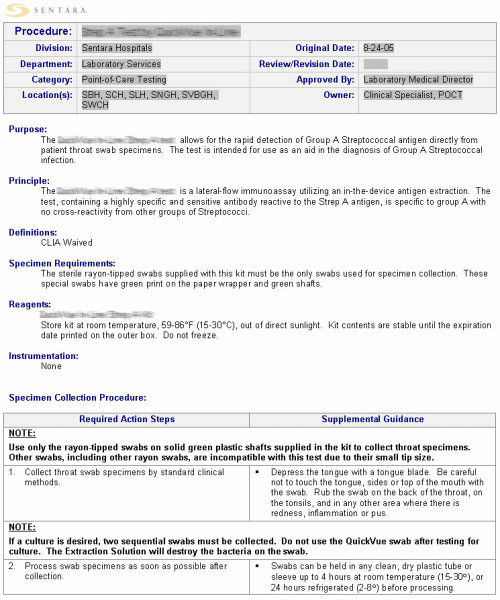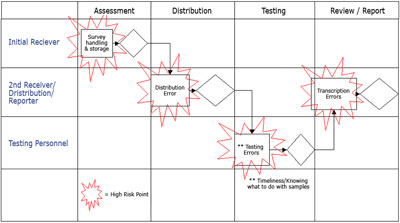Printed from acutecaretesting.org
January 2006
Preventing error in POCT with effective policies and procedures
There are several key drivers to a successful Point-of-Care Testing (POCT) program: effective training and competency programs, process control, standardization and communication (a biggie).
One area that is sometimes taken for granted is the POCT policy and procedure. Effective policy and procedure writing can contribute to error prevention.
When written properly, procedures should be easy to understand and follow; staff should know where procedures are located and actually use them!
Our organization has embraced a large safety initiative program that involves a transformational change in the way we develop policies and procedures. It is coined Focus & Simplify, and we believe our program can contribute to an error-free environment.
Sentara Healthcare developed Focus & Simplify in collaboration with Performance Improvement International. Focus & Simplify is about improving the effectiveness of work processes and procedure documentation.
The basic principles of Focus & Simplify are:
- Our processes should be efficient and designed to reduce the risk of error and failure
- Procedures should provide clear, concise guidance
- Job aids should serve to provide accessible, on-site tools that employees need to perform their work
- Procedures and job aids should be used in training new employees and reinforcing performance expectations
Focus & Simplify has two components:
Work-process simplification. Even before writing or revising a procedure, map the current work process, evaluate the process for risk and effectiveness, and then modify the process to reduce risk and improve effectiveness.
Procedure simplification. This involves using a new procedure structure that clearly articulates action steps, highlights points of risk and provides appropriate detail for experienced and new employees.
It also utilizes job aids to pull out of procedures the tools and references needed to accomplish a complex or infrequently performed task.
Our organization is taking a very methodical, incremental approach to implementing Focus & Simplify. Our senior leaders identify key processes that are characterized by high risk or high complexity, that have outcomes measures that are “in the red”, or that have a liability trend.
Some of these, of no surprise, are Fall Prevention, Medical Response Teams and Medication Management.
For each key process, a Process Owner is identified for each facility, and an Executive Sponsor is named. A Process Owner is an individual designated to maintain high-level understanding and oversight of a process, and who has defined responsibilities.
The Executive Sponsor provides high-level guidance to the Process Owner group, establishes goals and timelines, and assists in removing roadblocks to process improvement.
The Process Owners attend Focus & Simplify training. A mentor is then assigned to guide the Process Owner and a process team through their first application of Focus & Simplify.
Following a successful first application of Focus & Simplify, the Process Owner team continues to apply Focus & Simplify to other work processes within their area of focus.
The Focus & Simplify mentor continues to serve as a resource for the team.
The Process Owner’s job is to maintain knowledge of:
- Literature and best practices
- Regulatory requirements
- Process failure modes
and to:
- Achieve value-added standardization across hospitals
- Track key measures
- Drive process improvement and problem resolution
- Develop action plan if outcomes do not meet goals
Other groups can be trained in Focus & Simplify, even if they are not identified as a key process.
With a goal of ensuring that Focus & Simplify is effectively applied, training is scheduled to provide the optimum level of support to each group.
Across our six hospitals, the laboratory owned ~1500 policies and procedures. For this reason, we realized an opportunity to implement Focus & Simplify to see if we could not only rework some of our processes, but reduce error as well.
We started with a lesson in human error. It is important to understand how humans make errors and how errors lead to events.
HUMAN ERROR
As human beings, we all make errors, and accidents – or events – do happen. But few events are the result of a single human error. So how does an event occur? In most everything we do, there are checks and barriers built into what we do to help catch errors and prevent them from resulting in events.
James Reason in "Managing the Risks of Organizational Accidents" explains this with a chunk of Swiss cheese [1]. The slices of Swiss cheese represent those checks and barriers. Checks and barriers may be in the form of technology, processes or other people.
Sometimes, however, the checks and barriers fail. Those failures are the holes in the Swiss cheese. An error that otherwise would have been caught carries through the holes unstopped and results in an event.
HUMAN ERROR CLASSIFICATION
There are three categories of human activity and errors. Jens Rasmussen, a cognitive systems engineer from Denmark, developed the “Skill/Rule/Knowledge”-based classification [2].
The name of the error type describes the mode that your brain is in when you make the error.
Skill-based errors are those made when performing acts or tasks that require limited or no thought attention (auto-pilot). We know them as slips and lapses.
Rule-based errors are those made when performing acts or tasks that require application of rules – accumulated through experience or training – to familiar situations.
In these cases, a wrong rule may have been applied, the rule may have been misapplied, or one has chosen not to comply with the rule.
Knowledge-based errors are made when performing acts related to new or unfamiliar situations that require problem solving and for which a rule does not exist or is not known.
In these cases, one may try to figure it out but the strategy may be faulty.
The goal is to keep people out of the knowledge-based activity whenever appropriate and possible. This is because most errors are made in this mode and many of those go undetected.
It is important to design our work processes to keep people in the skill-based and rule-based activity where failure rates are much smaller and frequently detected.
Simple prevention strategies such as those in TABLE 1 help us reduce the risk of human error.
TABLE 1: Sentara Healthcare, Copyright 2004-2005
A derivative work product of Performance Improvement International, LLC
|
ERROR TYPE |
ERROR PREVENTION STRATEGY |
| Skill Based Errors | |
| Slips & Lapses | Stop and think before acting |
| Knowledge Based Errors | |
| Wrong rule | Educate |
| Misapplication of rule | Think a second time before acting |
| Non-compliance | Reduce burden, increase risk awareness, and/or coach or counsel |
| Rule Based Errors | Stop and consult an expert source |
Focus & Simplify - Process Workflow:
1. Map the process as it is performed today
Process mapping produces a visual representation of the process to ensure that everyone understands the process in the same way. Identify steps, roles, handoffs, states and transitions.Use a swim-lane flow chart to most clearly visualize and represent the process. NOTE: A process is a series of steps that takes an input, does something with it and produces an output.
The benefits of a process are that it improves safety and effectiveness and ensures repeatability.
2. Identify requirements the process must meet
These may be:
- Internal/external requirements
- Regulatory requirements
- Evidence-based practices
- Professional standards
- Customer expectations
3. Evaluate the process for risk and effectiveness
Identify steps that:
- Have a high risk and probability of failure
- Have a high error potential (bottlenecks, handoffs, improper task allocation)
- Are low-value or redundant
- Do not meet internal or external requirements
- Should, but do not, have accuracy monitoring
FIGURE 1 displays a swim-lane process map. The bursts indicate the high-risk areas – those easily prone to error.
These are the areas to concentrate on when assessing the process for risk and effectiveness.
FIGURE 1: Swin-lane process map
4. Modify the process to reduce risk
Consider adding for high-risk steps:- Review, verification, inspection and test activities
- Error-proofing techniques to help reduce probability of human error
- Check-offs to help work tracking
5. Modify the process to improve effectiveness
- Arrange steps to minimize motion
- Reassign job functions to minimize handoffs and to ensure appropriate assignment based on knowledge and skill
- Delete low-value and redundant steps
- Consider automation for repetitive actions and information processing
- Is the process and workplace intuitive?
6. Develop job aids
Job aids are documents that:- Help the employee complete a process step
- Provide memory aids for infrequent tasks
- Warn of hazards
Types of job aid
Forms, checklists, decision aids, reference guides, telephone lists, signs.7. Update the process map
Reflect improvements made to reduce risk and improve effectiveness.Focus & Simplify - Procedure Documentation:
Within our organization, policies are high-level expectations mandated by a regulatory requirement or self-imposed requirement. They are few in number and are for informational and reference use.
Using a two-column format, procedures are step-by-step required actions listed in column one, while supplemental guidance is offered in column two. Job aids are referenced within action steps.
Both procedures and job aids aid in achieving policy expectations. They are greater in number and should be used continuously as well as for reference use. These are the tools needed in the workplace to effectively carry out the work in the process.
8. Document the process as a procedure
The procedure must:- Provide accurate action steps
- Reflect complete information
- Be in correct sequence
- Provide the appropriate level of detail for the employees working in the process
9. Format the procedure effectively
- Procedure steps written as clear, concise phrases that begin with action words
- Place cautions and notes before the step to which they apply
- Do not use abbreviations
- Do not use vague terms and phrases
- Do not combine multiple actions in one step
- Reference job aids associated with action steps
FIGURE 2: The first page of a two-column formatted POCT procedure.

10. Determine if a policy is needed
Document a policy statement if there is a high-level outcome expectation mandated by a regulatory or accreditation requirement or by the organization.
Eliminate the policy statement if the current department policy reiterates a system or division-level policy OR if the “policy” statement really is a procedure.
11. Review for ease of understanding and use
It is important to review the policies/procedures with employees that work within the process and employees that work outside the process. Experienced operators should validate the procedures prior to implementation.
Inexperienced operators can bring value to this process as well by assuring that the steps will be interpreted without error.
12. Obtain appropriate reviews and approvals
Follow the approval processes for policies and procedures established within your organization prior to implementation.
OPERATIONAL STEPS AFTER FOCUS & SIMPLIFY
Once process changes have been identified and policies/procedures have been approved, re-educate current POCT operators on work-process changes and procedure-document changes.
Incorporate process and document changes into new employee-orientation curriculum and observe POCT-operator performance to ensure that changes are translated into work practice.
It is important to monitor and track outcomes to show improvements and reduction in error.
FOCUS & SIMPLIFY EXPERIENCE
As our first experience with Focus & Simplify, the lab management staff chose to evaluate the external Proficiency Testing process. Mapping the original work process took a few sessions to assure that we included all the steps involved in the different sections of the laboratory.
Assessing the steps for risk became obvious based on the historical frequency of errors with the current process. We then revised the process, developed one procedure for all sections of the laboratory and developed two job aids to help staff move through the process intuitively.
We have since eliminated the department-specific procedures in each section of the laboratory. We will track errors in 2006 to see if we are in fact reducing errors using this new process.
The new format for procedure documentation has also been well received with new and revised POCT procedures. Caution statements (using a bolded red font) and Notes statements (using a bolded black font) precede the action step to which it applies.
This keeps staff from missing an important message prior to performing an action step. POCT operators and even our Medical Directors have commented that this new format is much easier to follow.
Providing processes and procedures that have been evaluated for risk and effectiveness using the Focus & Simplify techniques is yet another key to an error-free POCT program.
References
- Reason J, Managing the Risks of Organizational Accidents. Burlington: Ashgate, 2001.
- Rasmussen J. Human error: a taxonomy for describing human malfunction in industrial installations. J. Occup. Accid. 1982; 4: 311-35.
References
- Reason J, Managing the Risks of Organizational Accidents. Burlington: Ashgate, 2001.
- Rasmussen J. Human error: a taxonomy for describing human malfunction in industrial installations. J. Occup. Accid. 1982; 4: 311-35.
May contain information that is not supported by performance and intended use claims of Radiometer's products. See also Legal info.
Acute care testing handbook
Get the acute care testing handbook
Your practical guide to critical parameters in acute care testing.
Download nowScientific webinars
Check out the list of webinars
Radiometer and acutecaretesting.org present free educational webinars on topics surrounding acute care testing presented by international experts.
Go to webinars









